Welcome back to the Lab!
Hello Bug Friends! Carolyn Taber, MBHI’s Museum Educator, here. I recently returned from spending a week in sunny (and buggy!) Hawaii with my extended family so I’m taking over Notes from the Lab to share with you some of the cool arthropods I saw and learned about during my adventures in Maui!
Hawaiian Spiders
Unsurprisingly, I am the go to “spider person” in my family. Throughout the trip I was alerted to all kinds of spiders hanging around on large and beautiful webs. While I couldn’t always take great pictures of them as their webs swayed in the breeze, I was able to snap this photo of the underside of what I believe is a Hawaiian garden spider.
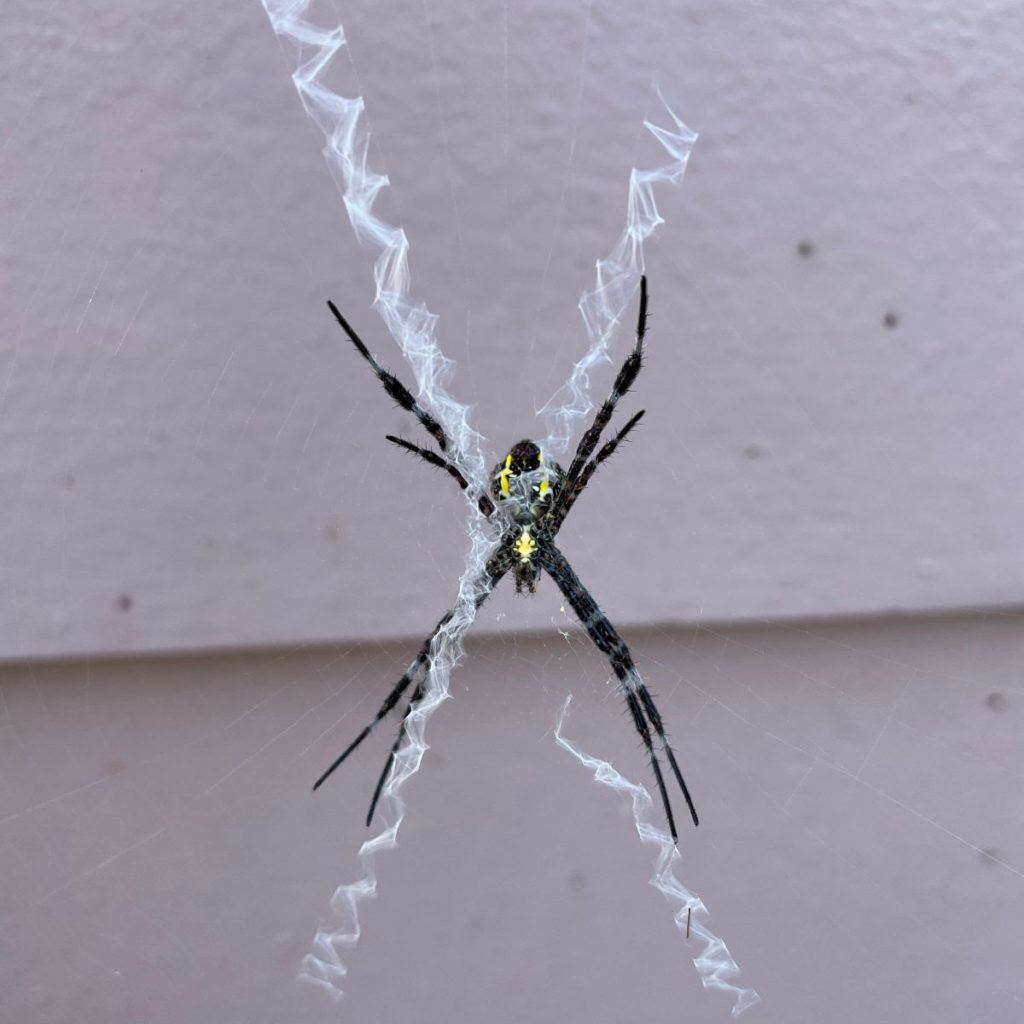
You’ll notice the thicker, zig-zag shaped lines on the web. Those lines are called stabilimentum and there is much debate around their purpose. Macquarie University (NSW, Australia) Biology professor M. J. Bruce notes that there are several hypotheses – “(1) protection against predators, (2) increasing foraging success, (3) prevention of damage to the web, (4) providing shade and (5) mechanical support for the web.” and that “the function of silk decorations may be context specific, depending on factors such as predators, prey, background color and ambient light.”
Another group of spiders I saw regularly were spiny orb weavers. Two common examples include the Spiny-backed orb weaver and the Asian spiny-backed orb weaver. These tiny and spiky guys were everywhere! While we’re on the topic of spiders, I would be remiss if I didn’t mention the Hawiian happy-face spider. I sadly didn’t see any of these beautiful spiders but just knowing that they exist brings me a good deal of joy. I mean, just look at that “face!” These spiders, Nananana Makaki’i in Hawaiian, are shy and nocturnal, living under leaves in rainforests.
Ashy Grey Ladybugs
Did you know that lady bugs can be WHITE? I didn’t either until we spotted some of these little cuties inside a flower blossom. These guys are called Ashy Gray Lady Beetles (Olla v-nigrum) and while they are related to the red lady bugs we see here in the spring and summer, they’re a totally different species.

Crustaceans
If you ever get the chance to go tide pooling with a three year old, I can’t recommend it enough. My nephew Teddy was incredibly curious about everything he was seeing and experiencing, exclaiming over and over “and there’s ANOTHER ONE!” each time he spotted another tiny snail or crab.
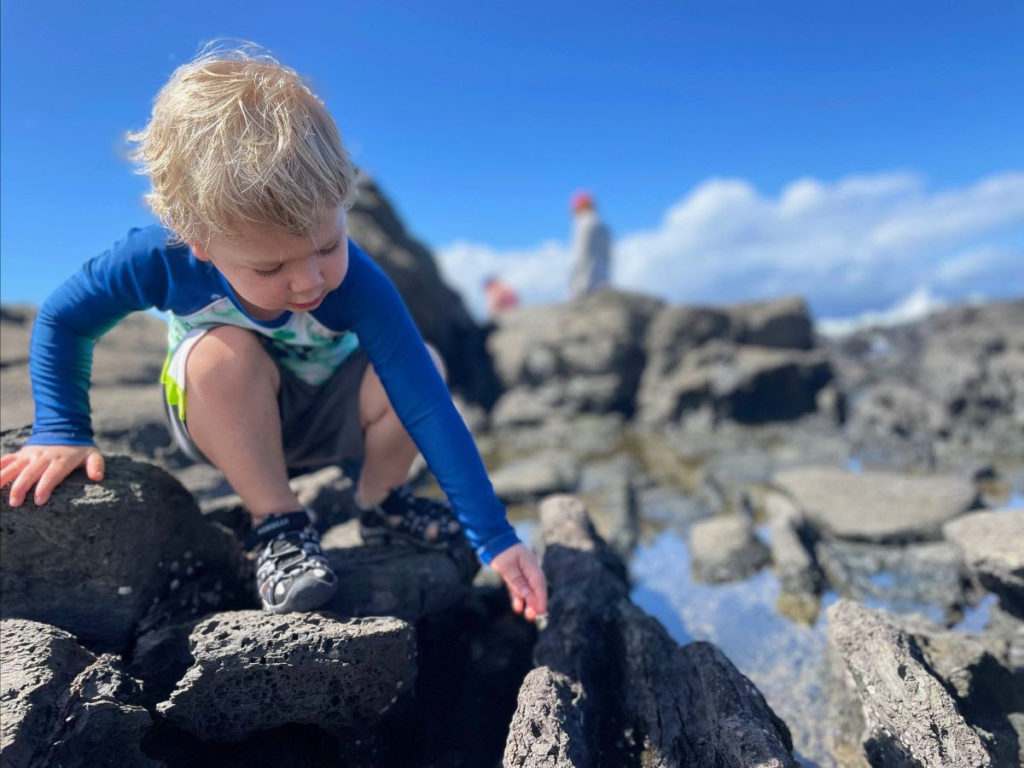
During our tide pool explorations at Napili Bay we spotted a creature that you might have spotted at our old location on Front Street – hermit crabs! According to the Waikiki Aquarium “There are over six species of hermit crabs found in Hawaii’s tide pools and reef shallows, each distinguishable by the colors of its eyes, antennae, legs, and claws.” Since I was helping to ensure my nephew didn’t get swept out to sea during our investigations, I don’t have an exact species identification to share with you but I can say that they were smaller than the ones we had on display. Check out Brenna’s “Captivating Crustaceans” Online Bug Encounter to brush up on your hermit crab biology.
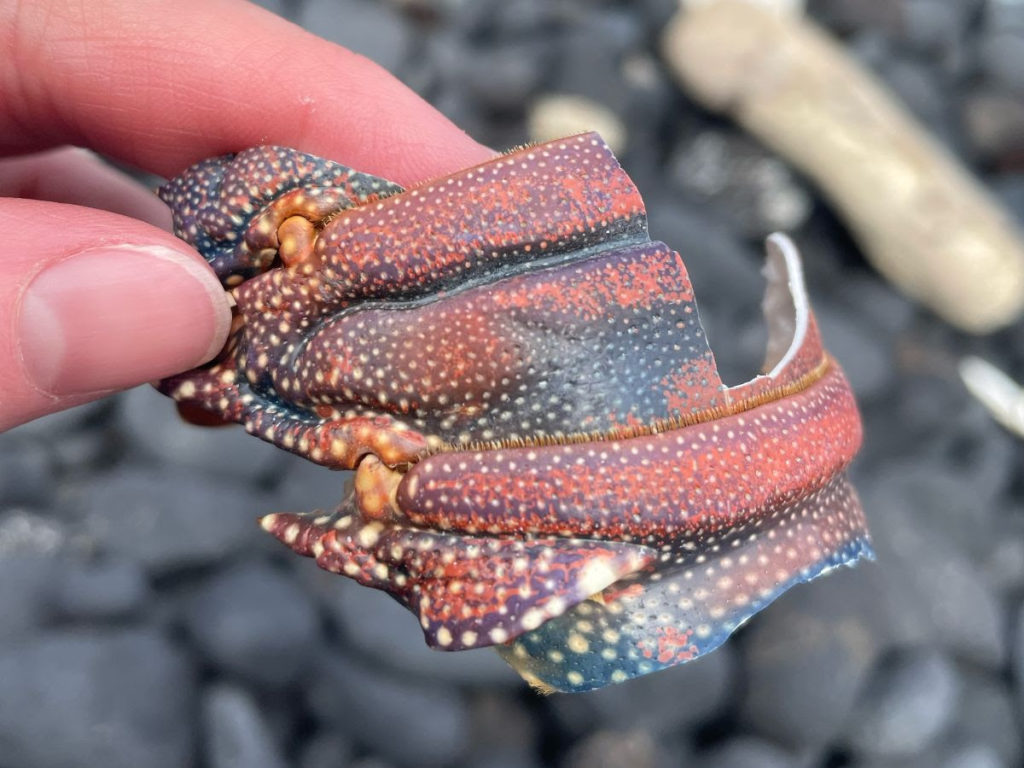
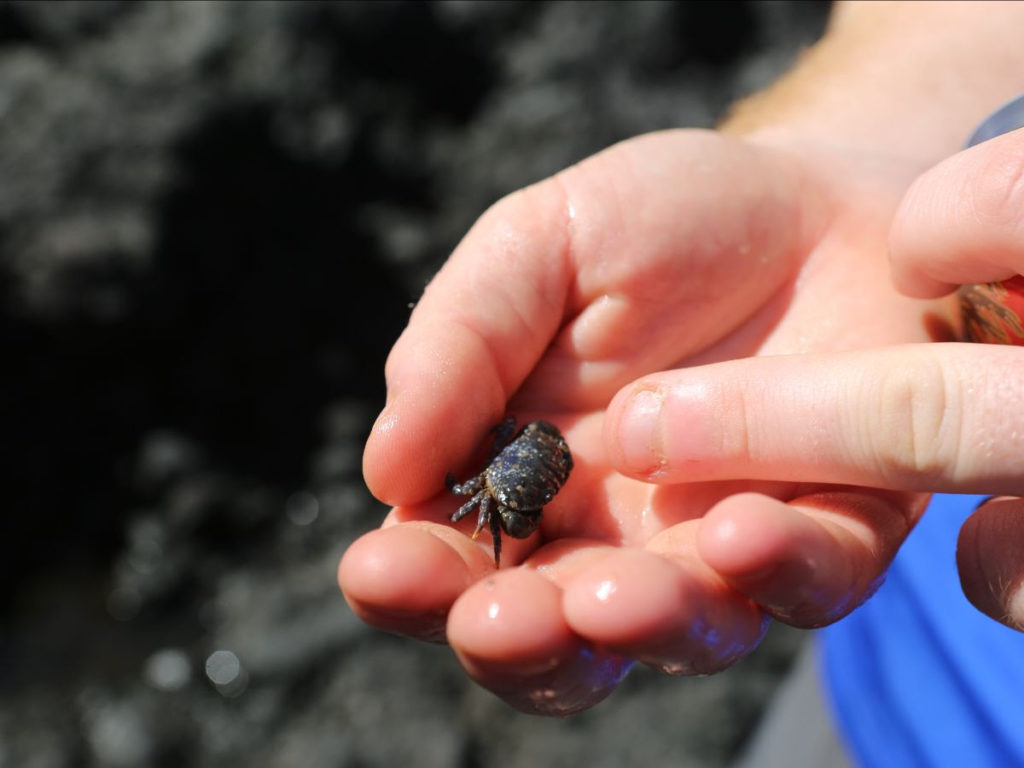
We spotted evidence of more crustaceans during our journeys – little crabs scurrying through tidal areas and exoskeletons of larger crustaceans that had washed up on black sandy beaches near the town of Hana.
Monarchs
I was lucky enough to tour a pineapple farm and, aside from the delicious samples and getting to see just how oddly pineapples grow, got to spot a few monarch butterflies mingling between the pineapples. The farm we were touring does not use herbicides and so milkweed seeds blow into their fields and grow alongside the pineapples, attracting the monarchs.
Monarchs showed up in Hawaii around 1850 and it isn’t clear if they got blown off course or arrived with human help. Hawaiian monarch butterflies have lower levels of cardiac glycosides in their tissues, the substance that makes them toxic to predators, “apparently because leaves of the major host plant, Calotropis gigantea (crown flower) contain a low amount of these compounds” according to Monarch Watch.
One last word on the Monarch butterflies of Hawaii – apparently there is a white variation of the species that is found in Hawaii! I didn’t see one myself but have enjoyed reading about them. More research is needed, and being done, to understand the origin of this variation and its relationship to its orange compatriots and predators.
Volcanic Arthropods
On our last day in Hawaii we were lucky enough to explore Haleakala National Park. The upper altitudes of the Haleakala volcano may look like a desolate or Martian habitat but plenty of arthropods call it home! I was most captivated by the relationship between the long-horned beetle Plagithmysus terryi and its host plant, silversword. Silversword, the beautiful plant pictured below lives only on the upper regions of the volcano and can grow to be 90 years old!
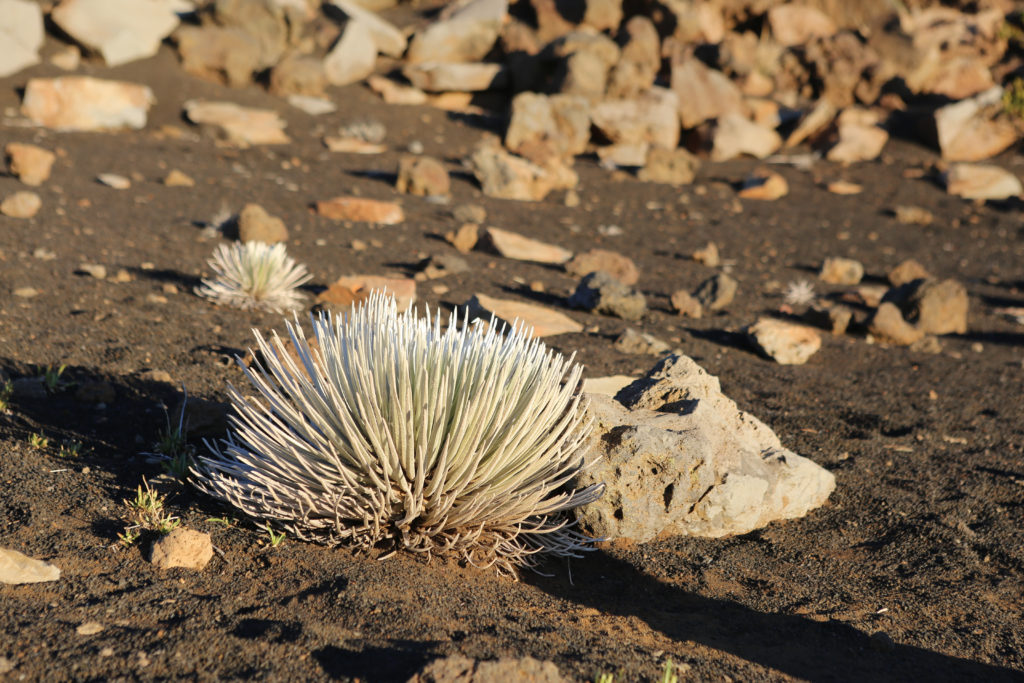
Developing beetle larvae eat the woody pulp and grow inside the plant, eventually pupating and emerging. While beetles sometimes weaken the plant so much that it topples over, typically silverswords are not harmed by this process. Also found on the upper reaches of the volcano are wolf spiders and flightless moths. Yup, you read that right – flightless moths! These moths evolved to be flightless over time, a reaction to the high winds of the upper elevations of the volcano no longer evolutionarily advantageous.
The Haleakala volcano complex is a great place to study beetles, evolution, and biodiversity. Cornell University entomology professor James Liebherr has spent over 100 field days studying and documenting round-waisted predatory beetles living on the slopes of Haleakala. He has so far discovered over 74 distinct, new species. The beetles, living in relatively small patches of forest isolated from other forest patches by lava flows, evolved and specialized in isolation, and resulting in such incredible biodiversity. This isolation and specialization unfortunately means that they are particularly vulnerable to climate change, invasive species and other disturbances. Learn more.
Invasive Species
Hawaii is a beautiful and remote ecosystem that has many uniquely adapted endemic species that are very sensitive to competition or disruption from invasive species. While we here at MBHI are big fans of ants – we’re not huge fans of invasive ants and Hawaii has a lot of them. While Hawaii has no native ants, there are over 60 species that have been introduced over the past 200 years. In fact, there are no species of eusocial insects that are native to Hawaii. While many of these introduced ant species are considered “low impact” some are having a direct impact on many aspects of a variety of Hawaiian ecosystems, agricultural systems, and human communities.
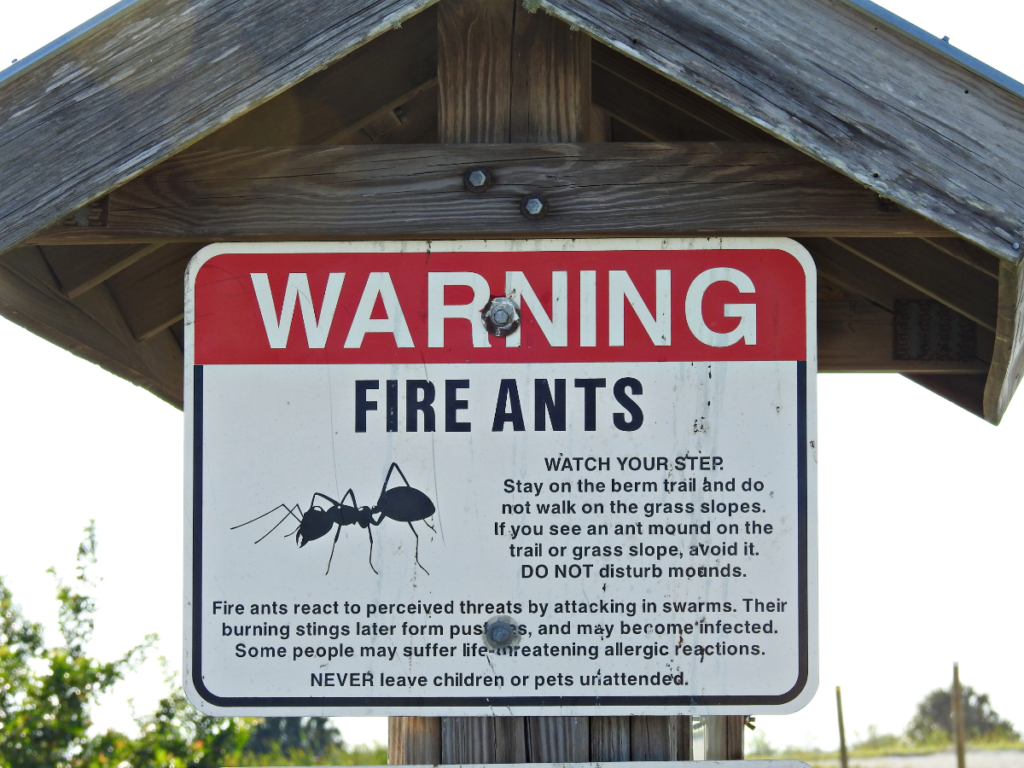
There are numerous community science programs, research and education initiatives across Hawaii aimed at educating the Hawaiian public and eradicating the most damaging of the destructive invasive ants. The Hawaiʻi Ant Lab (HAL), a program of the University of Hawai‘i Pacific Cooperative Studies Unit, is “dedicated to increasing knowledge about invasive ant biology, management, and eradication”. According to HAL, Little Fire Ants and their painful stings will push out native insects, can cause blindness in pets and livestock, have been shown to negatively impact sea turtles in other island habitats they have infested, and more. If you’ve ever wondered why there are so many regulations about bringing produce or other agricultural products into Hawaii, now you know!
Thanks for taking this journey to meet the bugs of Hawaii with me! Do you have any buys you’ve spotted on recent vacations? I hope you drop us a line to share everything you’ve spotted!
Until next time, thanks for visiting the lab!
Bug Wrangler Brenna
brenna@missoulabutterflyhouse.org
Want to revisit a previous Notes from the Lab issue? Check out our archive! Do you want to request a subject for an upcoming issue? Email me at the address above and put “Notes from the Lab” in the subject line.